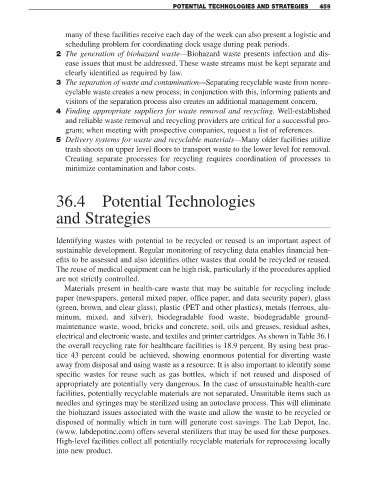Page 481 - Solid Waste Analysis and Minimization a Systems Approach
P. 481
POTENTIAL TECHNOLOGIES AND STRATEGIES 459
many of these facilities receive each day of the week can also present a logistic and
scheduling problem for coordinating dock usage during peak periods.
2 The generation of biohazard waste—Biohazard waste presents infection and dis-
ease issues that must be addressed. These waste streams must be kept separate and
clearly identified as required by law.
3 The separation of waste and contamination—Separating recyclable waste from nonre-
cyclable waste creates a new process; in conjunction with this, informing patients and
visitors of the separation process also creates an additional management concern.
4 Finding appropriate suppliers for waste removal and recycling. Well-established
and reliable waste removal and recycling providers are critical for a successful pro-
gram; when meeting with prospective companies, request a list of references.
5 Delivery systems for waste and recyclable materials—Many older facilities utilize
trash shoots on upper level floors to transport waste to the lower level for removal.
Creating separate processes for recycling requires coordination of processes to
minimize contamination and labor costs.
36.4 Potential Technologies
and Strategies
Identifying wastes with potential to be recycled or reused is an important aspect of
sustainable development. Regular monitoring of recycling data enables financial ben-
efits to be assessed and also identifies other wastes that could be recycled or reused.
The reuse of medical equipment can be high risk, particularly if the procedures applied
are not strictly controlled.
Materials present in health-care waste that may be suitable for recycling include
paper (newspapers, general mixed paper, office paper, and data security paper), glass
(green, brown, and clear glass), plastic (PET and other plastics), metals (ferrous, alu-
minum, mixed, and silver), biodegradable food waste, biodegradable ground-
maintenance waste, wood, bricks and concrete, soil, oils and greases, residual ashes,
electrical and electronic waste, and textiles and printer cartridges. As shown in Table 36.1
the overall recycling rate for healthcare facilities is 18.9 percent. By using best prac-
tice 43 percent could be achieved, showing enormous potential for diverting waste
away from disposal and using waste as a resource. It is also important to identify some
specific wastes for reuse such as gas bottles, which if not reused and disposed of
appropriately are potentially very dangerous. In the case of unsustainable health-care
facilities, potentially recyclable materials are not separated. Unsuitable items such as
needles and syringes may be sterilized using an autoclave process. This will eliminate
the biohazard issues associated with the waste and allow the waste to be recycled or
disposed of normally which in turn will generate cost savings. The Lab Depot, Inc.
(www. labdepotinc.com) offers several sterilizers that may be used for these purposes.
High-level facilities collect all potentially recyclable materials for reprocessing locally
into new product.

